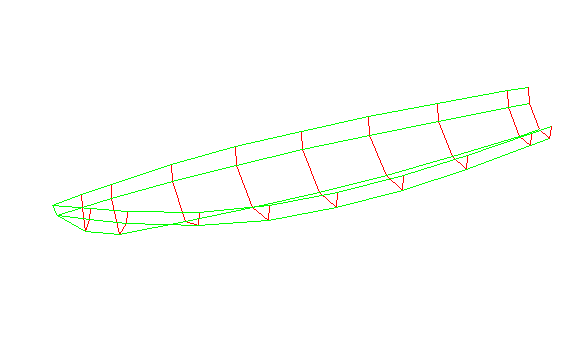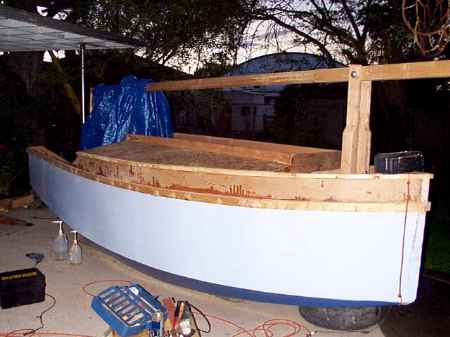
Chris Hill takes his Vireo14 out first time.
Contents:
Contact info:
Jim Michalak
118 E Randall,
Lebanon, IL 62254Send $1 for info on 20 boats.
Jim Michalak's Boat Designs
118 E Randall, Lebanon, IL 62254
A page of boat designs and essays.
(1feb06) This issue begins a discussion of a new design. The 15feb06 issue will continue the subject.
THE BOOK IS OUT!
BOATBUILDING FOR BEGINNERS (AND BEYOND)
is out now, written by me and edited by Garth Battista of Breakaway Books. You might find it at your bookstore. If not check it out at the....ON LINE CATALOG OF MY PLANS...
...which can now be found at Duckworks Magazine. You order with a shopping cart set up and pay with credit cards or by Paypal. Then Duckworks sends me an email about the order and then I send the plans right from me to you.

|
Left:
Chris Hill takes his Vireo14 out first time.
|
|
|
Raider Design #1
I TALKED TO A FELLOW....
...who had lived for a while near the Baltic Sea and still visited there often. He had participated in a "RAID" event there recently. He explained that a Raid event is sort of an escorted tour of row/sail boats which would cover several days and a lot of water but was not "roughing it" in that the boating was limited in time each day and housing and meals were provided for by the tour. It sounded to me of perhaps what the Tour de France bike event may have started as long ago but now that has become the most intense racing around. In the same way the Raid event is getting more serious in speed.
So he wanted a row/sail boat with the ability to seat four oarmen and a sail rig that could fold down quickly when rowing was serious and be raised quickly for times when it could be used to advantage including legs where folks would row while the sail is up and drawing. No need for a motor at all. No need to carry any extra gear or supplies since the tour support boats are always nearby. He told me to expect the four oarmen to total 700 pounds in weight.
SIZING IT UP...
So as we sized up the project we talked about 700 pounds of people and maybe 400 pounds of boat or about 1100 pounds total displacement. And room would be needed to let four oarsmen do their work. The sail rig would play second fiddle to the rowing (and I would suggest that the same boat with no sail rig but with trained oarsmen would outrun the row/sail version, but they might not enjoy the tour).
Now, if you sit on a low rowing stool, say no more than 12" high, you will find you need at least 3' of space from seat back to foot brace. I thought we might go for 4' to allow for bulkheads, etc.. Four rowers that way gives 16' of boat just for the crew, add a nice bow and stern and you are at about 24' total, and Norm agreed.
Shallow water was of no problem and although I thought the water might be wicked cold Norm assures me that at summer's end the Baltic water can be very nice and hopping out with wet feet no problem. With that in mind there was no need for a flat bottomed beaching boat and I suggest a V bottom as being the fastest thing to row. (It's shape would be a lot like that of Chis Hill's Vireo14 shown above.) Beam would need to be about 5'. More than that and the handling of oars might get difficult. Less than 4' and you get the same problem. This boat would be optimized for rowing so we would go with 5' giving a long narrow hull. It would also be fairly low to give good oar action. Sketching it up we ended with this on first try:

If we knew the overall size, the only thing left to guess at was how deep the V needed to be to float the weight. We wanted to float 1100 pounds in such a way that the sharp chines of the bottom/side joints would be out of the water in normal trim so no water would flow across them.
Now, when a boat pushes down into the water it makes a hole in the water. How big is that hole? The weight of the water displaced by the hole is equal to the weight of the boat. So here we have 1100 pounds to float, water weighs about 62 pounds per cubic foot, so the hole here would be about 1100/62 = 18 cubic feet. Now, our 24' hull is not going to make a hole 24' long because the bow is overhanging a bit. Let's say the effective water line length is 22' long. And the hole is 5' wide at its max. Now imagine a prizm that is 22' long, 5' wide and with a V cross section of depth D. Like this:

This prizm has a volume of .5 x (22 x 5 x D) which works out to 55D cubic feet. If our boat were just that prizm it would displace 62 x 55D = 3410 x D pounds of water. But our boat is streamlined on the ends a lot and does not displace that much. What boat designers have done over the years is keep track of how much the streamlining affects that prizm's volume and called that the "prizmatic coefficient". I've kept track of mine and can say with pretty good confidence that any normal rowing or sailing boat will have a Cp of .50 to .60. If you called it .55 you would always be within about 10% for this first guess which ain't bad. This boat is on the fine end of that range and I would use a first guess Cp of .50. So Raider would make a hole in the water that displaces about .5 x 3410 x D = 1700 x D pounds. If we are trying to float 1100 pounds, then we make the depth of the V at D = 1100/1700 = .65' which is about 8".
I GO METRIC...
So far I'm thinking all in English and so was Norm but he said the boat would be built in the Baltic and the plans would have to be in metric. I tried that about ten years back but gave up on it after a quick check showed a US builder who wants to work in metric has to special order all his tapes and tools. Well, now it is time for me to enter the nineteenth century. At first I thought I would design in English and convert the numbers to metric but that would mean the builder would always be working in oddball dimensions. So I gathered up some metric measuring sticks and dove in. No more working in 1/8 or 1/12 scale. But 1/10 scale fit well on my 2'x3' paper.
When I drew the lines I made it a convenient 7.3 meters long and 1.4 meters wide on the waterline, then 25cm deep in the V and added a bit of topside flare for looks for a top width of 1.5 meters. I made up a Hullforms model (which will work in metric) using offsets from my drawing and got this:

In 3D it looks like this:

It looks like this with some skin on it, very much like the Vireo14:

Hullforms told me on level trim she floats 1100 pounds at 9" draft so my guess was close. At 1320# she sinks 9.6" deep and at 1540# she sinks 10.2" deep. So when her sharp chine hits the water she will float about 1400 pounds which is more than we think we need. But everything gets heavier as time goes by....
NEXT TIME...
We muddle through the Raider sail rig.
Blobster
BLOBSTER, SAILBOAT, 16' X 6.5', 750 POUNDS EMPTY
Blobster has a lot of features I like in a boat. Lots of volume for its size, sort of like Micro or Scram Pram. The multichine shape is almost exactly like Scram's but this one does not have a Birdwatcher cabin. It has the more traditional cabin with a raised watertight deck behind. Also it has one feature I would love to have in my personal boats - a step-through bow so that when you beach you can go forward through the cabin and out the front without going into the water or climbing over the bow. The cabin also has a slot top roof.

This shape of boat with multichines has proven good in rough water and with fair speed in spite of its blobular proportions. Blobster has about 600 pounds of water ballast in its belly and should be OK to 90 degrees heel although such depends mostly on weight distribution of the crew, something the designer has little control over. On the other hand, if the crew jumps overboard the boat will be almost assured of righting without their help. Then the problem becomes reboarding. Be prepared!
Sail rig is a large but simple 139 square foot balanced lug on an 18' mast. Mast is stepped off center to allow you to walk upright down the slot top and out the front. Should be rigged in an instant with no one going on deck ever. All very low tech built with common materials but effective.

Blobster uses taped seam construction. Five sheets of 1/4" plywood, eleven sheets of 3/8" plywood and one sheet of 1/2" plywood.
Prototype plans for Blobster are $30.
Prototype News
Some of you may know that in addition to the one buck catalog which now contains 20 "done" boats, I offer another catalog of 20 unbuilt prototypes. The buck catalog has on its last page a list and brief description of the boats currently in the Catalog of Prototypes. That catalog also contains some articles that I wrote for Messing About In Boats and Boatbuilder magazines. The Catalog of Prototypes costs $3. The both together amount to 50 pages for $4, an offer you may have seen in Woodenboat ads. Payment must be in US funds. The banks here won't accept anything else. (I've got a little stash of foreign currency that I can admire but not spend.) I'm way too small for credit cards.
The out West Picara is I am told done to the point of using it as a powerboat:

The down South Picara is more or less complete now. Should have an updated photo soon.

This long and lean project is a 19' version of Toon2. Shown here on its first sail in very light winds. We will wait a bit longer to get a sailing report in stronger winds.

A Vector builder is keeping a website of the project at http://www.geocities.com/michsand@sbcglobal.net/ and here is a photo of his boat on its first sail, just before the storm hit. I also have photos of a Vector completed by Pete Mohylsky in Florida. Hopefully a report soon:

Here is a Musicbox2 I heard about through the grapevine.

We have a Philsboat going together in California:

And here is another Philsboat in northern Illinois:

AN INDEX OF PAST ISSUES
Hullforms Download (archived copy)
Plyboats Demo Download (archived copy)
Brokeboats (archived copy)
Brian builds Roar2 (archived copy)
Herb builds AF3 (archived copy)
Herb builds RB42 (archived copy)